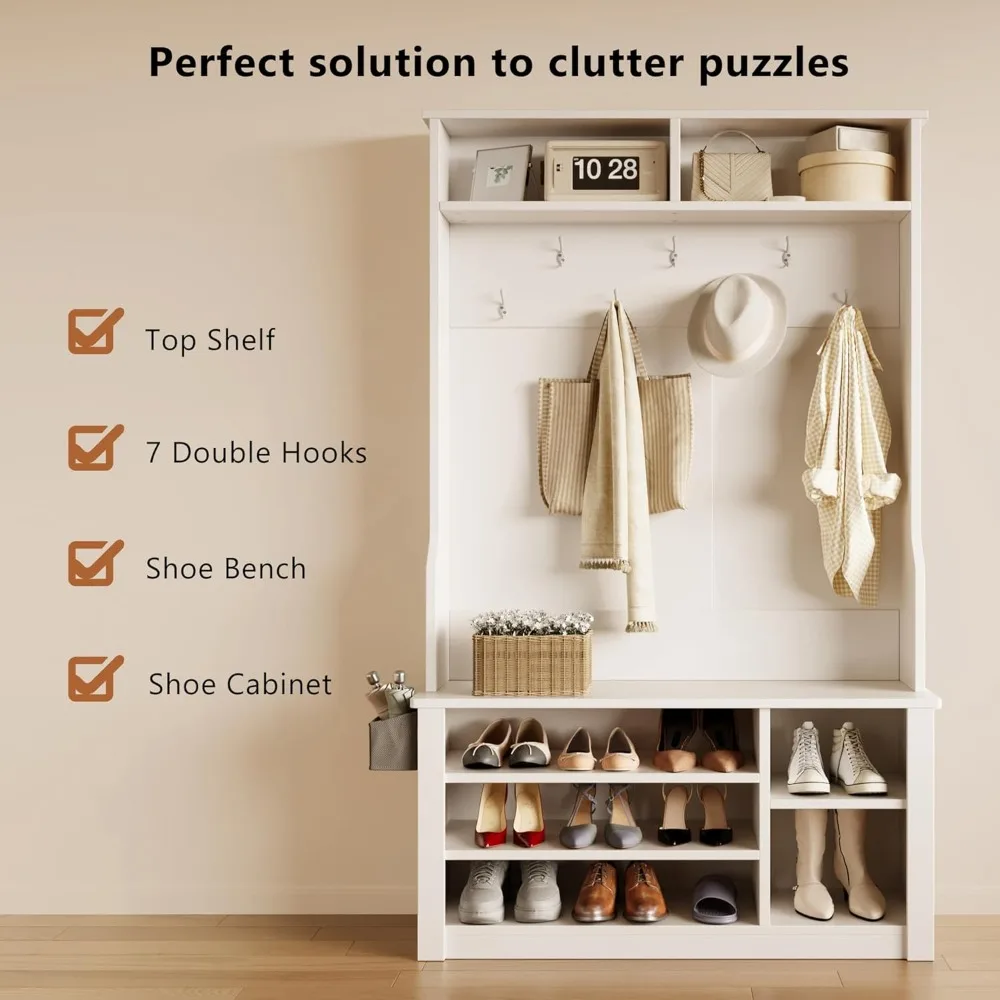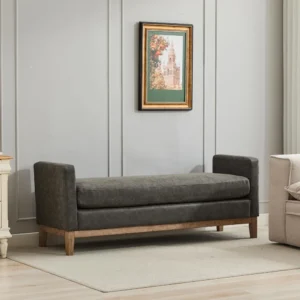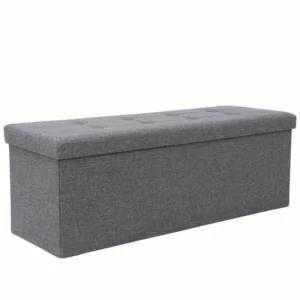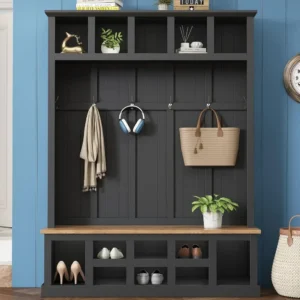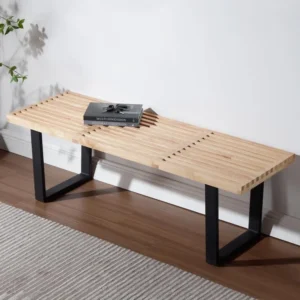Understanding the Small Mudroom Challenge
Creating a functional mudroom in a limited space can feel like solving a puzzle. Most small mudrooms or entryways range from just 15-25 square feet—barely enough room for a few people to stand comfortably. Yet these tight spaces need to accommodate everything from shoes and coats to bags and sports equipment.
The challenges that come with limited entryway space include:
- Clutter accumulation that quickly overwhelms the available area
- Insufficient storage for seasonal items like winter boots and summer hats
- Multiple family members trying to share the same cramped quarters
- Items spilling into adjacent living areas when not properly contained
A well-organized entryway does more than just look good—it transforms your daily routine. Imagine starting each morning without frantically searching for keys or tripping over shoes. Space-saving entryway benches provide practical solutions that make your home feel more welcoming while keeping essentials organized.
The right approach to space-saving entryway ideas can reduce morning stress, save precious minutes in your daily schedule, and create a positive first impression of your home. Many homeowners discover that multifunctional furniture designed specifically for small spaces can completely transform how their entryway functions—often without requiring any structural changes to the home itself.
Planning Your Space-Efficient Mudroom
Before purchasing any furniture, taking time to evaluate your specific needs and space constraints will ensure you make the best choices for your home. Follow these steps to plan effectively:
Measure accurately: Record the width, depth, and height of your available space, including any architectural features like doors that swing into the area or sloped ceilings that might limit vertical storage options.
Identify your storage priorities: Consider what items you most need to store based on your household’s activities. A family with young children might prioritize low hooks and cubbies, while someone with a dog might need dedicated space for leashes and pet supplies.
Map out traffic patterns: Ensure there’s enough space for people to move through the area, especially if it’s a main entry point to your home.
Define functional zones: Even in small spaces, try to create distinct areas for:
* Hanging items (coats, bags)
* Seating for putting on/removing shoes
* Closed storage for items you don’t want visible
* Open storage for frequently accessed items
When planning your space, be realistic about your budget while prioritizing quality. Well-designed small entryway benches might cost more initially but offer better functionality and durability than cheaper alternatives that waste precious space.
The key to successfully organizing a small entryway with benches is thinking vertically and choosing pieces that serve multiple functions. Look for narrow entryway benches specifically designed to maximize functionality while minimizing floor space usage.
Essential Mudroom Furniture for Small Spaces
When working with limited space, selecting the right furniture pieces becomes critical. The best small mudroom furniture follows key space-saving principles:
- Maximizes vertical space rather than floor space
- Serves multiple functions instead of a single purpose
- Offers concealed storage to reduce visual clutter
- Provides customizable organization options
- Features slim profiles designed specifically for tight spaces
Five essential categories of space-saving mudroom furniture stand out for their efficiency and versatility:
- Storage benches: Provide seating and storage in a single footprint
- Vertical storage systems: Utilize wall space for hooks, shelves, and cabinets
- Compact hall trees: Combine multiple functions in one unit
- Slim cabinets and consoles: Offer storage with minimal depth requirements
- Modular cubbies: Allow customizable organization based on specific needs
By strategically mixing and matching these furniture types, you can create a cohesive mudroom that maximizes functionality while maintaining your home’s style. For example, a mudroom bench paired with wall hooks and floating shelves might provide all the storage you need without overwhelming a small entry.
The best creative small mudroom organization solutions maintain a consistent design language that complements your home’s existing decor while providing smart storage solutions.
The Versatile Storage Bench: Seating and Storage Combined
Storage benches reign as the most practical furniture piece for small mudrooms because they serve two essential functions while taking up minimal floor space. When selecting a bench for limited space, consider these options:
- Lift-top benches: Provide concealed storage under the seat for shoes, bags, or seasonal items
- Drawer benches: Offer more organized access to smaller items without removing everything on the seat
- Open cubby benches: Allow air circulation for wet shoes while providing easy visual access
- Combination designs: Feature both open and closed storage sections for maximum versatility
For small spaces, look for benches less than 36 inches wide and 16 inches deep that still provide adequate seating for one person. Pay attention to the bench’s height as well—ideally between 17-19 inches for comfortable seating.
Material selection matters tremendously for durability in high-traffic areas. Look for:
- Solid wood or metal frames that support at least 250 pounds
- Water-resistant finishes that won’t be damaged by wet boots or umbrellas
- Easy-to-clean surfaces that maintain their appearance over time
- Cushions with removable, washable covers if you opt for padded seating
A mudroom bench with shoe storage offers the perfect combination of functionality for entryways where footwear tends to accumulate, keeping shoes organized while providing a place to sit while putting them on or taking them off.
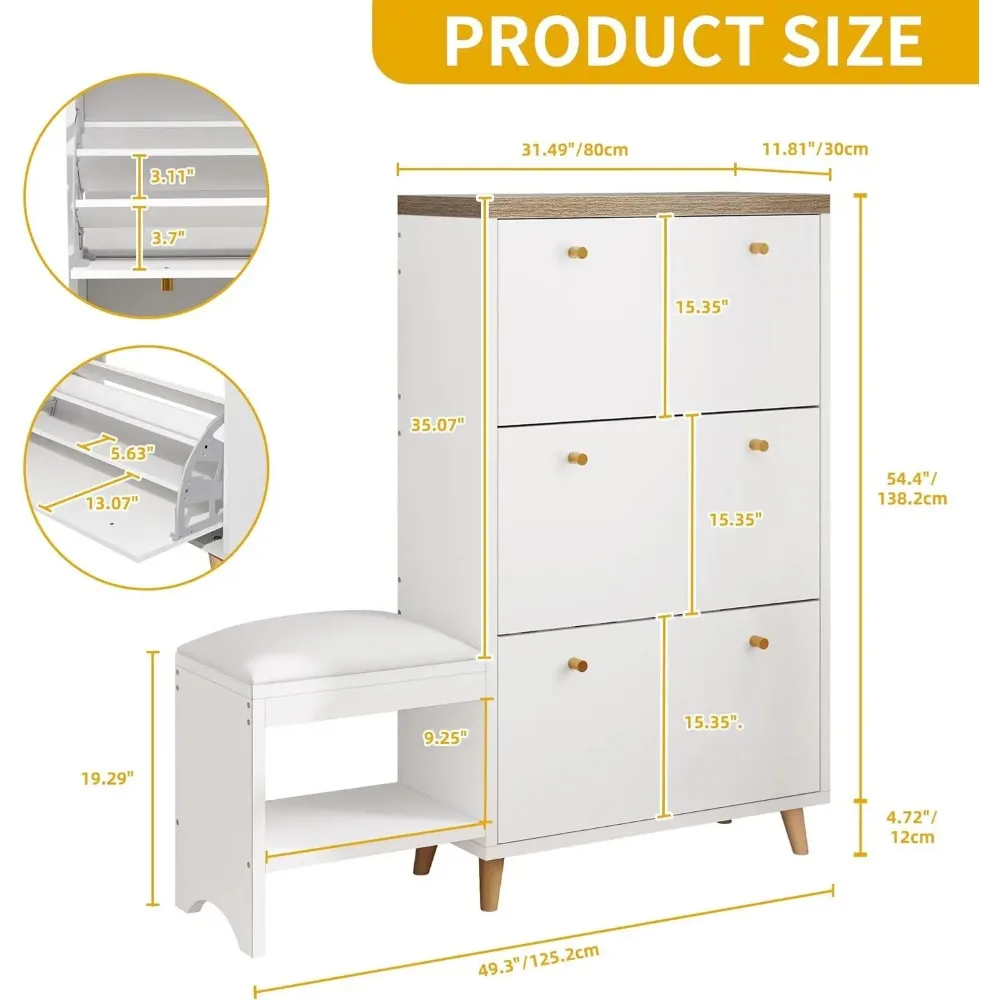
Vertical Storage Solutions: Maximizing Wall Space
When floor space is limited, your walls become valuable real estate for storage. Effective vertical storage solutions include:
Wall-Mounted Shelving Systems
* Adjustable track systems that can be reconfigured as needs change
* Floating shelves that provide storage without bulky brackets
* Corner shelving units that utilize often-wasted space
Hook Systems
* Multi-hook rails that provide organized hanging space
* Decorative individual hooks that double as design elements
* Swivel and folding hooks that can be tucked away when not in use
* Height considerations: 48-54 inches for adults, 36-40 inches for children
Slim Wall Cabinets
* Cabinets with 6-10 inch depth designed specifically for narrow passages
* Medicine cabinet-style designs with mirrors on doors to maximize functionality
* Hidden storage behind artwork or mirrors for valuable items
Pegboard and Grid Systems
* Customizable arrangements that can be adjusted seasonally
* Attachments designed specifically for different items (hats, scarves, keys)
* Space-efficient organization without permanent installation
When installing vertical storage, always consider wall construction and use appropriate anchors—especially for heavy items like coats and bags. The most efficient setups combine multiple vertical elements with floor-based storage like an entryway coat rack bench to create comprehensive organization while maintaining open floor space.
Compact Hall Trees: All-in-One Organization
For those seeking maximum functionality in minimal space, compact hall trees offer an elegant solution by combining multiple storage features in a single unit. When space is at a premium, look for hall trees with these space-conscious dimensions:
- Width: 24-36 inches for narrow spaces
- Depth: 12-16 inches to maintain walkway clearance
- Height: Utilizing vertical space up to ceiling height where possible
The most efficient hall trees for small spaces include:
- Built-in bench seating with hidden storage
- Multiple hooks at various heights
- Small shelves for keys, mail, and other small items
- Shoe storage beneath the bench
- Optional mirror to create the illusion of more space
When considering materials and construction, look for solid wood frames or metal construction with cross-bracing for stability. Even in tight spaces, hall trees should support at least 250 pounds of weight to accommodate both seating and hanging items.
For particularly challenging spaces, corner hall trees offer an ingenious solution by utilizing often wasted corner space. These triangular units fit snugly where two walls meet, providing organization without protruding far into the room.
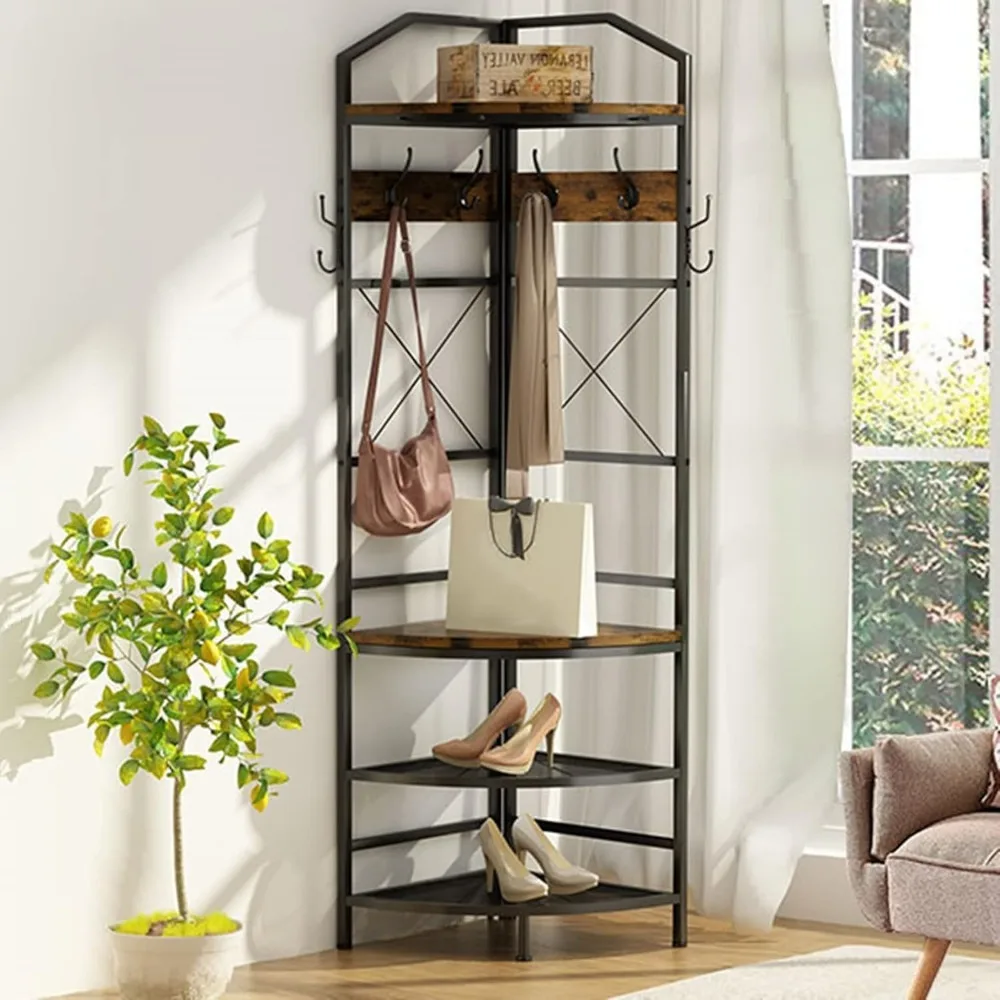
Slim Cabinets and Narrow Consoles: Depth-Saving Designs
When passage space is your primary concern, slim storage furniture with reduced depth offers ideal solutions. These pieces are designed to provide maximum storage capacity while projecting minimally into your walking path.
Shallow-Depth Cabinets
* 10-12 inch depth (compared to standard 16-24 inches)
* Full height for maximum storage volume
* Adjustable shelving for customized storage
* Doors that don’t require extensive swing space
Tilt-Out Shoe Cabinets
* Ultra-slim 6-8 inch depth when closed
* Space-efficient vertical shoe storage
* Hidden storage that reduces visual clutter
* Easy access without bending down
Narrow Console Tables
* 10-12 inch depth for tight hallways
* Drawer storage for small essentials
* Open shelving below for baskets or shoes
* Surface space for keys and mail
The reduced depth of these pieces makes them perfect for narrow hallways where traditional furniture would create obstacles. Many shoe storage benches utilize clever tilt-out or pull-out mechanisms to store footwear in a fraction of the space required by conventional storage methods.
For particularly narrow spaces, consider space-saving hallway benches that are specifically engineered for tight corridors while still providing essential storage and seating functionality.
Modular Cubbies and Lockers: Personalized Organization
For homes with multiple family members, individualized storage helps maintain organization by giving everyone their own dedicated space. Modular systems allow for customization based on your specific space constraints and family needs.
Space-Efficient Cubby Systems
* Individual cubbies measuring 12×12 inches for personal items
* Stackable units that can grow with changing needs
* Configurations that fit specific wall dimensions
* Options for both open and closed storage
Open vs. Closed Cubby Considerations
* Open: Better air circulation for wet items, visual reminders to stay organized
* Closed: Conceals clutter, protects items from dust, creates cleaner appearance
Personalization Strategies
* Color-coded bins for different family members
* Customizable labels or name tags
* Differently sized compartments based on individual needs
* Adjustable components that adapt as children grow
These systems work particularly well when combined with seating, as found in mudroom benches with cubbies. These combination pieces offer a complete organization solution that makes effective use of limited space while encouraging family members to maintain their own areas.
For maximum functionality in tight spaces, space-efficient mudroom bench solutions often incorporate vertical cubby storage above seating areas to create complete organization centers with minimal footprints.
Smart Accessory Solutions: Beyond Furniture
The right accessories can dramatically enhance the functionality of your mudroom furniture while requiring minimal additional space. Consider these space-maximizing additions:
Storage Containers and Baskets
* Slim bins designed to fit specific furniture dimensions
* Clear containers for easily identifying contents
* Collapsible options for seasonal storage
* Washable materials for items like hats and gloves
Zero-Footprint Organizers
* Over-the-door hook systems and pockets
* Hanging organizers for small accessories
* Magnetic strips for metal keys and tools
* Adhesive hooks that require no installation
Specialized Storage Helpers
* Umbrella stands with drip trays to contain moisture
* Mail sorters that mount to walls
* Key hooks placed near the door
* Boot trays that protect flooring from water damage
* Pet leash hooks and treat containers
These accessories work best when selected to complement your existing furniture. For example, choose baskets that slide perfectly into your bench cubbies or hooks that match the finish of your hall tree. The goal is creating a cohesive system where every item has a designated place without adding visual clutter.
Entryway Bench with Cushion, Mudroom Bench with Cushion, Shoe Bench for Entryway
$1,186.63 Select options This product has multiple variants. The options may be chosen on the product pageCoat Rack Shoe Bench, Corner Entryway Bench, Corner Hall Tree, Shoe Bench for Entryway
$313.58 Select options This product has multiple variants. The options may be chosen on the product pageEntryway Bench with Shelf Storage, Shoe Bench for Entryway, Shoe Storage Bench
$194.08 Select options This product has multiple variants. The options may be chosen on the product pageBench with Hooks and Storage, Entryway Hall Tree, Mudroom Bench with Cubbies, Mudroom Bench with Shoe Storage
$818.38 Select options This product has multiple variants. The options may be chosen on the product pageModern Entryway Bench, Wood Entryway Bench, Wood Mudroom Bench
$497.69 Select options This product has multiple variants. The options may be chosen on the product pageEntryway Coat Rack Bench, Entryway Hall Tree, Farmhouse Mudroom Bench, Mudroom Bench with Shoe Storage
$805.09 Select options This product has multiple variants. The options may be chosen on the product page
Design Strategies for Visually Expanding Small Mudrooms
Strategic design choices can make even the smallest mudroom feel more spacious and welcoming. Consider these visual expansion techniques:
Color Choices
* Light, neutral colors for walls and larger furniture pieces
* Consistent color palette throughout to create visual flow
* Accent colors used sparingly to prevent visual fragmentation
Mirror Placement
* Opposite entry doors to create depth illusion
* Full-length mirrors that visually double the space
* Mirrored cabinet doors that serve dual purposes
Lighting Techniques
* Layered lighting with overhead, task, and accent options
* Under-shelf lighting to illuminate dark corners
* Motion-activated lights for convenience and safety
* Light fixtures that don’t protrude into limited headspace
Visual Continuity
* Consistent flooring between mudroom and adjacent spaces
* Furniture that complements your home’s overall style
* Clean lines that don’t visually crowd the space
When selecting furniture finishes, consider durability first—high-traffic areas need materials that withstand daily abuse from wet boots, bags, and outdoor gear. The best small benches for entryways balance attractive design with practical features like water-resistant finishes and scratch-resistant surfaces.
Multi-Functional Furniture Selection Guide
When every inch counts, use this checklist to evaluate potential furniture purchases for your small mudroom:
Space-Saving Assessment
* Measures less than 36 inches wide for most small spaces
* Depth under 16 inches to maintain adequate walkways
* Vertical design that utilizes height rather than floor space
* Slim profile with minimal protrusions
Multi-Functionality Checklist
* Combines at least two functions (seating, storage, hanging, etc.)
* Storage capacity appropriate for your household size
* Adjustable components that adapt to changing needs
* Accessible storage that will actually be used daily
Quality Indicators
* Solid construction with quality joinery (dovetail, mortise and tenon)
* Metal hardware rather than plastic components
* Smooth-operating drawers and doors
* Weight capacity appropriate for intended use
Style Considerations
* Complements adjacent rooms’ decor
* Classic design that won’t quickly look outdated
* Finish that coordinates with existing flooring and trim
Before finalizing any purchase, create a simple sketch of your space with measurements and furniture placement. This planning step helps avoid costly mistakes and ensures your selected pieces will actually fit and function in your specific space.
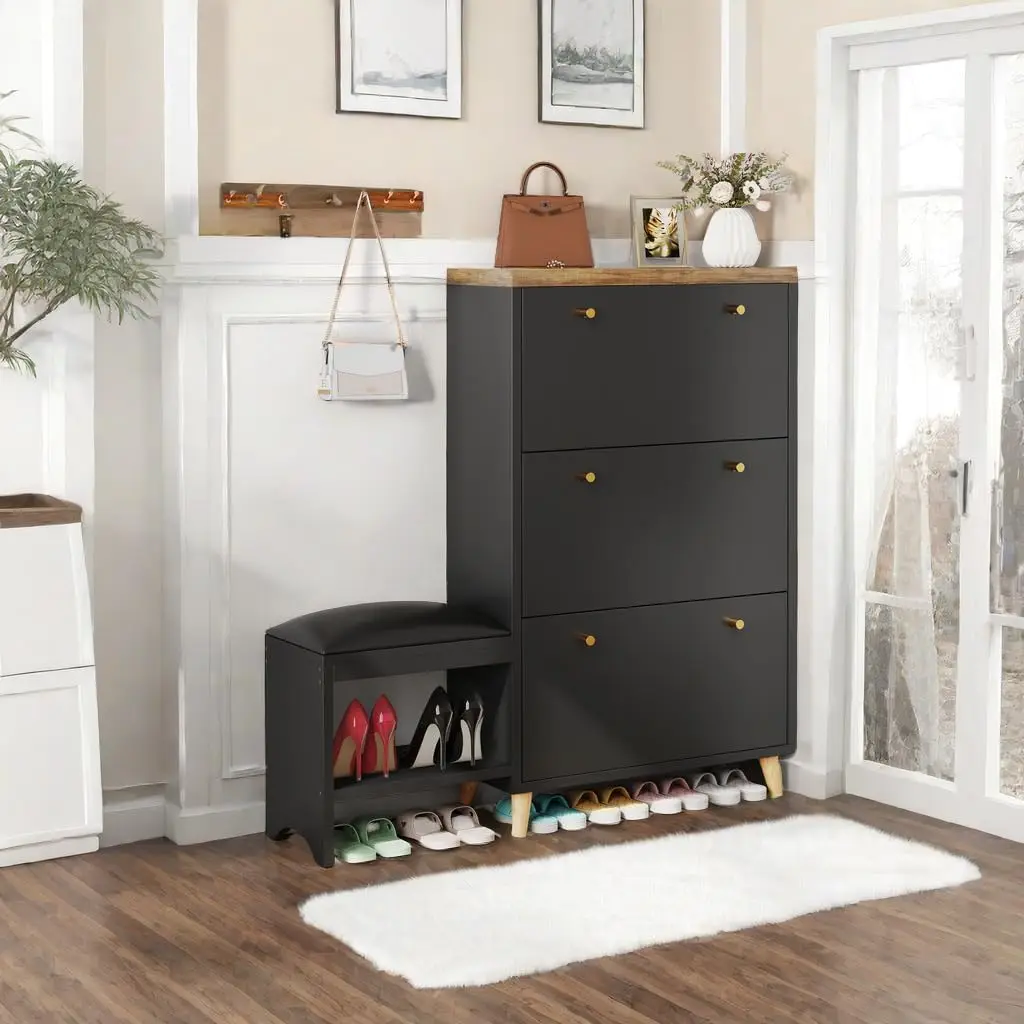
Maintaining Organization in Your Small Mudroom
Even the best-designed small mudroom requires ongoing maintenance to remain functional. Implement these practical habits to keep your space working efficiently:
Daily Quick-Cleanup Routine
1. Return items to designated places immediately upon entering
2. Hang coats and bags rather than draping over furniture
3. Place shoes in proper storage rather than leaving on floor
4. Sort mail and dispose of junk immediately
Weekly Maintenance
1. Wipe down high-touch surfaces like hooks and bench tops
2. Return misplaced items to their proper homes
3. Empty and clean boot trays and umbrella stands
4. Vacuum or sweep accumulated debris
Seasonal Rotation Strategies
* Store off-season items in labeled bins in another location
* Keep only current-season gear in prime mudroom space
* Schedule quarterly purging of outgrown or unused items
* Adjust hook heights and storage configurations as needed
Getting the whole family involved is crucial for maintaining organization. Create simple systems that even young children can follow, such as color-coded hooks or picture labels for younger family members who can’t yet read.
Creative Solutions for Specialty Items and Unique Challenges
Some organizational challenges require thinking beyond standard furniture solutions. Here are creative approaches to common mudroom dilemmas:
Sports Equipment Management
* Vertical wall-mounted racks for balls and gear
* Mesh bags hanging from hooks for small items
* Slim rolling carts that can be moved as needed
* Ceiling-mounted storage for seasonal items like sleds
Pet Supply Organization
* Wall-mounted food and water bowl stations that flip down
* Leash hooks at pet-specific heights
* Hidden litter box areas beneath benches
* Sealed containers for treats and food
Children’s Item Containment
* Lower hooks and cubbies at accessible heights
* Clear bins so kids can see contents
* Simplified systems that encourage independence
* Rotation systems for seasonal school supplies
Awkward Space Solutions
* Custom-cut corner benches for unusual angles
* Furniture on casters that can be reconfigured as needed
* Under-stair storage utilization
* Half-height solutions for sloped ceilings
For apartment dwellers or those in smaller homes, creating a functional entry often means being particularly creative with entry shoe storage furniture solutions that can fit in minimal spaces while still providing essential organization.
Bringing It All Together: Space-Saving Mudroom Furniture Combinations
Creating an effective small mudroom means combining various space-saving elements into a cohesive system. Here are proven combinations for different space constraints:
Ultra-Narrow Entry (24-30 inches wide)
* Wall-mounted hook system at multiple heights
* Slim shoe cabinet with tilt-out storage
* Small floating shelf for keys and mail
* Mirror above to expand visual space
Standard Small Entry (3-4 feet wide)
* Narrow storage bench with hidden compartment
* Wall-mounted hook rail above bench
* Floating shelves above hooks
* Slim cabinet on adjacent wall if space permits
L-Shaped Corner Configuration
* Corner bench with storage underneath
* Hooks on both adjoining walls
* Cubby system on one wall
* Mirror strategically placed to expand space
One-Wall Solution
* Full-height hall tree with integrated bench
* Additional hooks at different heights
* Shoe storage beneath seating
* Wall-mounted mail and key organizer
The most successful small mudroom designs at Nested Goods combine furniture pieces that share consistent design elements—similar wood tones, complementary hardware, and cohesive styling. This creates a purposeful look rather than appearing as disconnected pieces forced into a small space.
When budget constraints exist, focus first on the most essential functions: a place to sit, storage for shoes, and hooks for hanging items. Additional elements can be added over time as budget allows, creating a phased approach to your perfect small-space mudroom.

